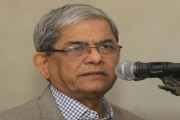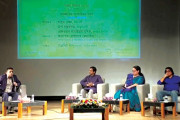।। Parvez Uddin Chowdhury ।।
Late December 2021, a-45-year-old Rohingya man and his wife came to our office in one of the camps at Teknaf. Devastated and crying, they told us that their 16-year-old boy was missing for more than a week and that they had searched for him everywhere in vain. They cried, repeating that their boy was very obedient, always stayed at home and never went anywhere without informing them.
Roughly two weeks later, the couple came again and told that their child called them from a jail in Thailand. Their child explained to them how he had gone with some other boys attempting to go to Malaysia, but on the journey he had badly injured his leg and then they were arrested in Thailand.
What makes a child only at the age of 16 leave the camps in Cox’s Bazar and venture on such a perilous journey to Malaysia? When I visited the boy’s house and spoke to his parents, it was obvious that he had lost all hope and he felt that without education or the ability to work, he had no future in the camps. He was frustrated, and without informing his parents, he left.
According to latest data, over 51% of Rohingya refugees are children who are growing up without access to formal education. The reports of child protection concerns such as abuse, violence, neglect, child labour, child marriage, child trafficking, children being used for drug trafficking, are on the rise.
There are more than 3000 NGO-led temporary learning centers providing informal education to primary-aged children, yet these were closed for more than one and half years because of the Covid pandemic. In September 2021, schools were reopened for four short months before the government closed all educational institutions again due to rising Covid infection rates of the Omicron variant. From March 2022, these learning centers are now reopened.
”In 2017, Bangladesh set a great example for all humanity by providing refuge to nearly one million Rohingya refugees who fled a genocidal campaign led by the Myanmar military”
Like most parents, Rohingya understand the importance of education and want nothing more than to see their children learn. However, over the years, most parents lost confidence in primary level education supported by humanitarian agencies because the Myanmar curriculum was not used, teachers were not well qualified, and their children were not able to spend enough hours in the classroom. Given prolonged Covid related lockdowns, the parents turned to community-led schools as their last hope for many Rohingya children to receive an education using the formal Myanmar curriculum or for any education during this time.
On 13 December 2021, Bangladesh issued a directive to shut down the only education options children had left: home-based, community-led private schools and madrasa in the camps without any rationale provided. In response to this directive, the UN’s Special Rapporteur on Myanmar, Tom Andrews expressed ‘deep concern’ and warned against this directive saying it will risk leaving a generation of Rohingya children practically uneducated.
In 2017, Bangladesh set a great example for all humanity by providing refuge to nearly one million Rohingya refugees who fled a genocidal campaign led by the Myanmar military. However, since then, Rohingya refugee’s lives have been sometimes devastated by various natural disasters and sometimes by short-sighted policies of Bangladesh like shutting down community-led schools and demolishing Rohingya shops. Given the rising incidents of violence and killing in recent times, security presence has been increased by setting many check posts and erected barbed wire fencing around the camps. These may lead to temporary short-term benefits such as an increase of arrests, but it will not address the drivers of conflict and insecurity in the long-run.
Many scholars researching peace and sustainability in the camps have argued that Bangladesh’s policies on access to education are bad for refugees and to national and regional peace. Without education, children and youth may be targeted by groups wishing to radicalise and enlist them in violent and criminal activities. They have suggested Bangladesh provide formal education for all Rohingya children and adolescents for its own good, not just because it is an undeniable basic human right.
There is no doubt that quality formal education helps keep children safe, strengthens their resilience, and teaches them right from wrong and to care for their community. There is no better way to protect children without education. Through education, Rohingya children and youth will have the knowledge and skills to be ambassadors of positive change in their households, sub-blocks, and in the camps at large. Thus, it will help promote peace and stability. But in the last four years, without formal education, Rohingya youth activists have become frustrated and lost hope.
”Bangladesh could improve conditions while refugees remain in Bangladesh by improving shelters, expanding access to formal education, and ensuring refugees have some access to livelihood opportunities to take care of their families’ needs”
‘Education cannot wait’ is the name of the United Nations global fund for education in emergencies. The name itself has much to tell us. It is a powerful statement to express how important education is and that it cannot be delayed, no matter where children are. The UN Convention on the Rights of the Child (UNCRC) of 1989 is considered to be a historic and complete statement of the children’s rights and it is the most widely ratified human rights treaty in history. It states that education is a basic right that every child is entitled to irrespective of their nationality, gender, caste, and ethnicity.
More than four years into their displacement now, the Rohingya crisis has become protracted. Bangladesh’s top priority since the beginning of the crisis has been safe repatriation which is supported by all stakeholders as well. Rohingya refugees want to return to Myanmar too, but one year ago those responsible for the atrocities that led to Rohingya’s displacement to Bangladesh came to power through the military coup in Myanmar. Since then conflict has only intensified meaning repatriation is likely a long way off. But as years going by, what Bangladesh will do with refugees until safe repatriation happens is a question that should be raised and answered.
Bangladesh could improve conditions while refugees remain in Bangladesh by improving shelters, expanding access to formal education, and ensuring refugees have some access to livelihood opportunities to take care of their families’ needs. This would help children and their families be more resilient, equip them with the skills and knowledge to return to Myanmar and make families more able to withstand various natural disasters and the influence by criminal groups.
* Parvez Uddin Chowdhury is a humanitarian worker. He can be reached at p.uddinchy@gmail.com










































































































































































